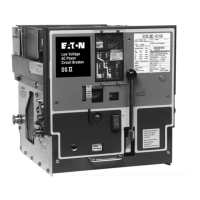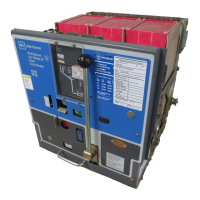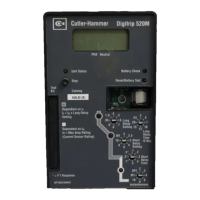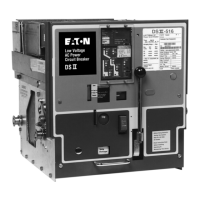Page
38
Figure 4-12d shows the REMOVE position. Here the
interlock cam stops with the shutter interlock pin blocked.
The shutter stays down and the breaker stays tripped
when the levering crank is removed. The breaker is held
trip-free and cannot be closed.
In
addition, another inter-
lock, described later, stops the close-release latch from
being released.
4-5.6 SPRING DISCHARGE INTERLOCK
The spring discharge interlock operates the close-
release latch as the breaker is moved out beyond the
TEST position. This causes a trip-free operation of the
closing mechanism because it occurs while the levering
crank is still on the worm shaft, and the closing springs
are charged on a power operated breaker. This is
because the levering crank is still being used to move the
breaker in the final part of its travel to the DISCONNECT
position. The trip plate is still pushed
in
and the breaker is
trip-free.
Figure 4-13 shows the essential parts of the spring dis-
charge interlock. Figures
4-13a and b show the levering
device in the -remove position. The interlock plate has
two horizontal pins (7 and 8) extending from it, as
shown in Figure
4-13. The upper one is designate Pin
"A" and the other Pin "B". In levering the breaker out to
the REMOVE position, the levering shaft turns counter-
clockwise until the levering device arms are horizontal to
the rear (Figures
4-13a and b). As it rotates, the close
bar cam is rotated counterclockwise by Pin "B" to the
CLOSE position. This releases the spring release latch
through the linkage shown in Figure 4-13. This results in
a trip-free operation of the breaker if the closing springs
are charged. It happens because the levering crank has
the trip plate held in the "Trip" position. If the breaker is
manually operated, levering out can be stopped at the
TEST position. Remove the levering crank and (1) close
the breaker and (2) trip the breaker. This will discharge
the springs
so
that, when the REMOVE position is
reached, there will not be a trip-free operation. The
close bar is merely pulled into the "Close" position.
4-5.7 CONNECTED BREAKER MANUAL CLOSE
INTERLOCK
The purpose of this interlock is to provide a choice
between being able to close the breaker by pushing on
the close bar and not being able to, with the breaker in
the CONNECT position. Referring to Figure
4-13a, the
interlock plate assembly is keyed loosely to the levering
device shaft by a drive pin. If the interlock screw is omit-
ted, the interlock plate can be rotated freely on the shaft
about 1
O degrees. This is because the wide slot is con-
l.B.
694C694-02
siderably wider than the drive pin. If the interlock screw
is
in
place in the narrow slot, the interlock plate has
practically no play and is forced to rotate exactly as
much as the levering device rotates.
Figure
4-13c shows the standard arrangement without
the interlock screw, with the levering device arms
in
the
CONNECT position. Note that there is a clearance
between the back of the hook and Pin "A". This permits
the close bar to be pushed to the "Close" position and
the breaker to close.
All parts in Figure
4-13d are in the same position as in
Figure
4-13c, except that the interlock screw is placed in
the narrow slot. This forces the interlock plate
to
rotate
about 10 degrees further than in Figure
4-13c.
In
this
case, there is almost no clearance between Pin "A" and
the back of the hook. Consequently, the close bar can-
not be pushed
to
the "Close" position. The breaker can,
however, be remotely closed by supplying control volt-
age to the spring release coil through a control switch
or
other circuit making device.
4-5.8 ELECTRIC LOCKOUT EQUIPPED BREAKER
Manually operated breakers can be equipped for electric
lockout. This means that closing an unenergized circuit
is prevented. This can be the main circuit or any other
desired circuit. It is accomplished by making it impossi-
ble for the required spring release device to release the
spring release latch unless the monitored circuit is ener-
gized. The spring release coil (SR) is wired through the
contact on the auxiliary switch, a front panel closing
pushbutton switch, and to the terminals of the circuit
being monitored. When the monitored circuit is ener-
gized properly, the breaker can be closed through the
panel pushbutton switch, provided that the closing
springs are charged.
As an additional safeguard against undesired closing
under this electric lockout condition, all such breakers
are provided with the interlock screw described in the
previous paragraph (4-5.7). This prevents hand closing
of the breaker in the CONNECT position.
4-5.9 CLOSED BREAKER INTERLOCK
Figure 4-14 shows how operating of the spring release
latch is prevented when the breaker is already closed.
The close bar is connected to the spring release latch by
a link and bell crank. The link is pivoted on the lower end
of the close bar cam by a pin. As the close bar is
pushed, the pin and latch link move to the right along
with the lower end of the cam. The lower end of the link
Effective
07
/97
Courtesy of NationalSwitchgear.com

